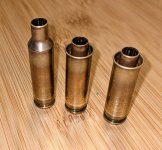I like the re-ordering on when I would clean. I'll work on implementing that. looking at a few more cases, these ones look particularly dirty in the inside. I think it may be the case that the tumbler was overfilled, leading to poor pin distribution to all of the cases. I'll likely experiment a bit to ensure I do actually get the case necks clean.
I also do chamfer ID and OD edges of the cases post wet tumbling.
I anneal to a target hardness level on the case necks. It is possible that I have brought the brass to a softer condition further down the axial length from the shoulder than necessary. I don't see this as an actual issue other than in this instance due to what is likely poor IML cleaning. As for the safety aspect, the case head is full hardness post this annealing schedule (time, power and position).
I did size and form 48 other cases without any issue, so that gives me a bit of pause on how I ensure consistency. These while not my highest precision (the only component swap is brass brand), are still desired to be precision loads.
This thread of advice in only a few hours time in the wee hours of the night is awesome. I love the raw feedback when someone can look at some photos and say, nope, your too dirty in x position. It's truly great.
My take always thus far:
- Verify annealing position, is the hardness in the case shoulder too low. (section a case and verify hardness on axial length)
- double check mandrel holder position, re-measure clearance to sholder.
- Run a few cleaning tests, clearly cases are not as clean as desired.
- Clean post anneal, graphite lube inside diameter of neck before mandrel expanding, and see if problem persists.

